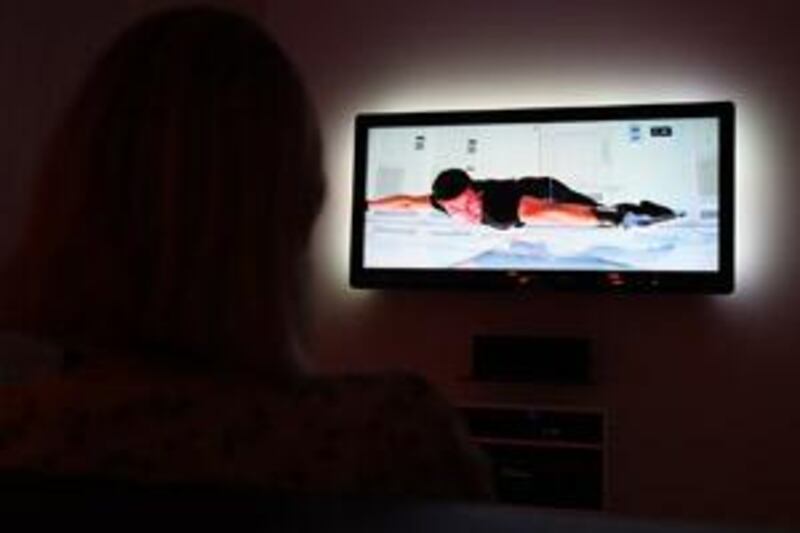While most technological advances seem to produce increasingly shrunken results - consider mobile phones, computers and iPods - a few are still resolutely insisting on growth. In the world of televisions, bigger is better, and the launch of a new, larger flat screen can drag even the most ardent couch potato off the sofa and to the store. So it was with something of a drum roll that the Philips Cinema 21:9, the world's first cinema-proportion television, was launched in the UAE last week. The home cinema is not a new concept. Giant screens and surround sound have improved the viewing experience beyond what anyone content with a few grainy black and white images ever imagined. Essentially, of course, you are watching the same thing - it's just more "immersive" when it sounds like an explosion is taking place around you rather than inside the screen and the picture is so razor sharp that you can practically smell the napalm.
Such is the idea behind the Philips Cinema 21:9, so called because its 21:9 ratio makes it the first to match exactly the format in which directors shoot films. Don't go thinking it will cover the entire wall: at 56 inches, there are plenty bigger (including Panasonic's whopping 103-inch model). But, as the sales people kept pointing out, what is ground-breaking about this product is its proportion and aspect ratio.
A quick note about aspect ratios: old-style square televisions had an aspect ratio of 4:3. Newer flat screens have one of 16:9. But since directors shoot films in 21:9, in order to fit most 16:9 screens the picture must either be boxed in, resulting in black lines above and below the picture or its sides cut off, meaning some of the picture is missing. With a ratio of 21:9, you are able to watch the film exactly as it was intended, with a 33 per cent bigger picture.
You could argue that black lines aren't exactly deal-breakers. Or that a few inches cut off at either end won't have a huge impact on the plot. But, according to Porus Sheriar, senior customer marketing manager at Philips, seeing films in the cinema is a more pleasurable viewing experience because it is closer to our eyes' natural aspect ratio - meaning, therefore, that the Philips Cinema 21:9 should be the same. It called for a road test.
It was unfortunate when I arrived at the Sharaf DG store in Dubai, which stocks the model, that I was mistakenly led to an actual mini-cinema, complete with enormous screen and comfy, tiered seating. As I gasped at the authenticity of it all, the mix-up was discovered, and I was instead shown another room with a considerably smaller flat screen, no tiered seating and a karaoke demonstration taking place next door. Not quite what I had been expecting, but after all this talk of aspect ratios, I was curious.
Such a trial calls for a particular type of film. There is no point, after all, in watching Jane Austen when you have every inch of the screen to play with. After I had spurned the nightmare that is Batman and Robin, it was left to Mission Impossible to enlighten me. As well as its unique aspect ratio, the Philips Cinema 21:9 also features the Ambilight, a back light that projects ambient LED lighting from the top and sides of the screen. Not only does it claim to "expand the content beyond the confines of the screen", but it also softens the effect of the screen's glare on your eyes. As the glow changed from pink to blue to red (the colour and brightness adjust to match what's on the screen), watching Tom Cruise's wire work did feel like an altogether calmer experience.
But was it more cinematic? Yes, I think it was. Though with a 16:9 you do get used to black lines, it's infinitely better without them. And together with the back light, I did feel unusually "immersed". The product, says Sheriar, is being marketed at a "niche segment of cinema lovers", since its advantages when it comes to watching regular television are limited (the news and many other day-to-day programmes are still formatted in 4:3). But, he adds, 50 per cent of the satellite television we watch is made up of films anyway.
For all its viewing advantages, though, it may be a case of what you don't know you don't miss. I will probably find the black lines on my television deeply irritating now, wonder what is taking place in the hidden reaches at the side and blame my headaches on a lack of Ambilight. But for many others, they will continue in blissful ignorance, happy in the knowledge that they have a 103-inch television - even if it is playing in 16:9.
The Philips Cinema 21:9 costs Dh19,999 and is available exclusively from Sharaf DG, Times Square Mall and Dubai Mall, and DG For You, Dubai Marina. Call 800 344 357.










